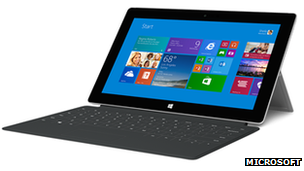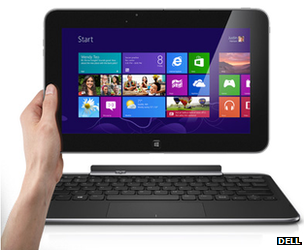Microsoft upgrades Surface tablets after financial hiccup
- Published

The Surface Pro 2 tablet can be paired with an optional docking station
Microsoft is updating its range of Surface tablets following weak sales of the original models.
The updates include faster processors and higher-resolution screens and cameras.
Both the ARM-based Windows RT version and Intel-powered Windows 8 edition are being upgraded.
The firm previously posted a $900m (£560m) writedown after building more of the first-generation RT versions than it could sell.
Analysts said demand for Microsoft's devices might continue to lag behind rival products.
However, they added that the firm's support for the product line was part of a long-term strategy that might ultimately pay off.
Windows-based tablets accounted for a 7% share of global shipments in the April-to-June quarter, according to a study by the tech advisory service Gartner.
By contrast, it said, Android-based tablets - including Samsung's Galaxy series, Android's Kindle Fires and Google's Nexus-branded range - had a 48% share, while Apple's iPads took 45% of the market.
"Our outlook for the RT tablets is very low because consumers are still confused about what they are getting with the platform and we aren't seeing a big uptake in the business market," said Roberta Cozza, a research director at Gartner.
"The 'pro' [Intel-based] range may do a bit better. The release of a new docking station and other accessories will help.
"But they're still quite pricey so it's unlikely to be a huge leap forward."
Many were surprised when it was first revealed that Microsoft was going to make its own Windows hardware because of concern the move would damage sales of other manufacturers' PCs, encouraging them to focus efforts on rival platforms.
More memory
Both of the new tablets now feature displays capable of showing video in full 1080p high-definition resolution - a feature that was previously limited to the "pro" models.
The upgrade also sees the RT version gain a 3.5 megapixel front camera and a 5MP rear one - making them both capable of capturing 1080p video.
The pro mode, however, retains the 720p-resolution camera found in its predecessor.
The Intel-based version does get Intel's fourth-generation Core i5 processor, which Microsoft said should help it attain 60% better battery life than the first model.
Buyers also get the option of more memory than before with up to 512GB of storage and up to 8GB of Ram - allowing them to run more programs at once.
The RT version becomes one of the first devices to be powered by Nvidia's ARM-based Tegra 4 processor and now features a USB 3 port for faster file transfers. Microsoft said it should attain up to 10 hours of video playback.

The add-on Touch Cover keyboard now comes with backlit keys to help people use it in the dark
Both models stick with a 10.6in (26.9cm) display, confounding rumours that the US firm would seek to launch a model to compete with the smaller iPad Mini and Nexus 7.
In addition, Microsoft has unveiled a thinner and lighter Touch Cover keyboard, which now has backlit keys, and promises to release a £165 docking station for the pro model next year to make it easier to attach it to an external monitor and other peripherals.
The RT Surface will cost between £359 and £439 while the cheapest pro models will be between £719 and £1,439 depending on the configuration. In both cases that is more expensive than prices for the original editions.
Retaining RT
Microsoft's decision to persevere with an ARM-based model comes despite the earlier writedown and complaints that the platform cannot run legacy software.
That means some high-profile programs are unavailable, including iTunes, the Chrome and Firefox browsers, the full version of Photoshop, many popular video games and many existing in-house software programs used by companies.
Taiwanese firm Asus announced in July that it was putting off plans to launch more RT devices because of this issue. Samsung, Acer and Lenovo have also shied away from the platform, although Dell continues to support it.
Using ARM-based chips does reduce costs and offer longer battery life. One expert suggested Microsoft might also want to keep RT alive to give it the option of merging it with its handset operating system at a later point.

Dell continues to offer its own Windows RT tablet which is cheaper than Microsoft's new models
"It's a long-term plan," said Chris Green, principal technology analyst at the Davies Murphy Group consultancy.
"It's about establishing a platform that could take four or five years to succeed in a similar way to the fact that early versions of Android didn't set the world on fire, but after its third or fourth iteration it became dominant and liked.
"However, running what are effectively three separate Windows platforms is fairly illogical and expensive, so I believe Microsoft will ultimately merge Windows RT with Windows Phone."
The release of the new Surface models is Microsoft's first hardware announcement since it revealed a 5.4bn-euro ($7.2bn; £4.6bn) planned takeover of Nokia's hardware division.
There are unconfirmed reports, external that the Finnish firm has been developing a Windows RT tablet of its own.
- Published13 September 2013
- Published3 September 2013
- Published31 July 2013
- Published15 July 2013